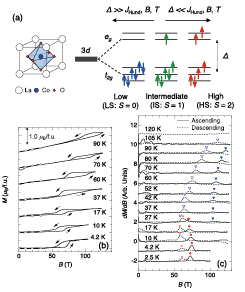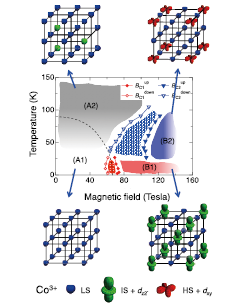Novel Spin State Ordering in LaCoO3 Discovered at above 100 T
Y. H. Matsuda and Kindo Groups
In transition metal oxides (TMO), various exotic phenomena emerge such as superconductivity, colossal magnetoresistance, metal-insulator transition, multiferroics and so forth. All these phenomena are considered to originate in the electron correlation that gives rise to the quantum many body effects. Then, the emergent orders appear due to the coupling of multiple degrees of freedom in solids such as spin, charge, lattice. Among TMO, cobaltites are regarded unique for their spin state degree of freedom. For example in the case of the most intensively studied LaCoO3, the electronic state of the trivalent cobalt ion (3d6) is classified into low spin (LS), intermediate spin (IS) and high spin (HS) state according to the total spin angular momentum S = 0, 1, 2, respectively, based on the single ion picture.

Fig. 1. (a) Schematic drawing of the perovskite structure and electronic configurations of spin state of LaCoO3 (b) Magnetization (M) and (c) dM/dB curves of LaCoO3 measured using induction method up to 130 T generated with the single turn coil method.

Fig. 2. (a) Magnetic field – Temperature phase diagram of LaCoO3 determined by the magnetization measurements. (b) Tentatively proposed configurations of the spatial ordering of the spin state and orbitals in LaCoO3.
One of the most interesting phenomena expected in cobaltites is the ordering of spin states, which is, however, not observed in general except for the limited cases such as thin films or special materials. Actually, in the case of LaCoO3, no order of spin state has been found for more than half a century. LaCoO3 undergoes the anomalous change in the magnetic and electric properties in the thermal evolution. In fact, even what kind of spin states are involved is still a major matter of debate.
Recently, it becomes clear that high magnetic fields can be used to directly observe the magnetic excited state of LaCoO3. At ISSP UTokyo in 2009, the magnetization jump of 0.5 μB/Co at about 60 T was found [1]. At Los Alamos High field laboratory in 2012, another magnetization jump at 70 T was found by measurements up to 100 T [2]. It has been proposed that the spatial ordering of different spin state called spin state crystalline (SSC) phase is realized at high magnetic fields. However, for the confirmation of the SSC, the study up to even more high temperature and high magnetic fields is needed.
In Fig. 1 (b) and (c), we present the measured magnetization (M) and dM/dB up to 130 T and up to 110 K. We found an obviously new magnetic phase at above 100 T and at above 35 K along with the previously found phase of above 65 T and below 35 K in Fig. 2 (a) [3]. We at this moment are considering the origin of the novel phase as follows. At the phase (A1), all Co ions are in LS state. With increasing temperature at the phase (A2), thermally induced IS or HS of Co ions appears with spatially disordered manner. With increasing magnetic field, the phase transition from (A2) to (B2) takes place accompanied with the sudden increase of the number of IS or HS species and also accompanied by the formation of the spatial ordering or IS or HS and LS species, namely, the SSC. In (B2), further order such as orbitals may also be possible on the background of the SSC. With decreasing temperature, another phase transition takes place between (B2) and (B1) without changing the magnetization. At this moment, it is difficult to clarify what is happening in the phase transition between (B1) and (B2). We note that the representative possibilities are the order-disorder phase transition of orbitals, the switching between the different orbital order, the switching between the different SSC. Tentative schematics of such spin state and orbital order are depicted in Fig. 2 (b).
Actually, the origin of the discovered high field phases (B1) and (B2) in LaCoO3 is still an open question. Besides the possibilities mentioned above, the possibilities of the field induced excitonic condensate and the SSC are investigated very recently with the calculations based on the dynamical mean field theory motivated by the present result [4,5]. For further investigation of the origins of the phase (B1) and (B2), different kind of experimental efforts such as the magnetostriction, magnetoresistance, x-ray diffraction at even higher magnetic fields, and the exploration of family materials are quite in demand.
References
- [1] K. Sato, A. Matsuo, K. Kindo, Y. Kobayashi, and K. Asai, J. Phys. Soc. Jpn. 78, 093702 (2009).
- [2] M. M. Altarawneh, G. W. Chern, N. Harrison, C. D. Batista, A. Uchida, M. Jaime, D. G. Rickel, S. A. Crooker, C. H. Mielke, J. B. Betts, J. F. Mitchell, and M. J. R. Hoch, Phys. Rev. Lett. 109, 037201 (2012).
- [3] A. Ikeda, T. Nomura, Y. H. Matsuda, A. Matsuo, K. Kindo and K. Sato, Phys. Rev. B 93, 220401(R) (2016).
- [4] A. Sotnikov and J. Kunes, arXiv:1604.01997.
- [5] T. Tatsuno, E. Mizoguchi, J. Nasu, M. Naka, and S. Ishihara, arXiv:1606.01681.
